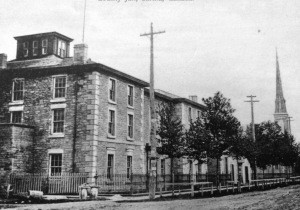by Phil Egan
She lies entombed today beneath a concrete parking lot behind a motel and a popular restaurant. Much of her story has been lost to time, and almost completely forgotten.
The tragic case of Elizabeth Workman was a classic travesty of justice, and it happened right here in our town.
Shortly before 9:00 a.m. on June 19, 1873, Elizabeth Workman plunged six feet to her death at the end of a rope on the gallows of the old Sarnia Jail. Fifteen observers watched her die, few of them completely convinced that she deserved her fate. She had been executed contrary to the wishes of the jury, the mayor of Sarnia, a future prime minister, and over 1,000 petitioners in the town.
The basic facts of the case are not in dispute. Elizabeth had beaten to death with a mop handle her drunken, abusive and much older husband, James. It had happened in an age when the murder of a husband by a wife was considered a crime only less heinous than treason.
James Workman was a habitual drunk who had subjected his wife to years of physical and verbal abuse. His mistreatment of Elizabeth was often so severe that she and her young son, Hugh, had been forced to seek shelter with a neighbour. Elizabeth, on the other hand, was known as a kind, hard-working, pious and industrious woman who worked ceaselessly to provide for her poverty-stricken family while her husband lazed at home with his bottle.
At the time of James Workman’s murder, Elizabeth had been employed by a black barber in his mid to late thirties named Samuel Butler. Prejudice was still alive in Sarnia in those days, and townsfolk were scandalized. Suggestions were made that their relationship was morally illicit, despite no evidence supporting the rumours.
When he drank too much, James would often become abusive about the relationship, and caused a drunken scene in Butler’s shop just days before the crime. The abuse continued at home for days.
Elizabeth apparently decided that she had suffered enough. It has been suggested that Elizabeth did not actually intend to kill her husband, but within two days of the beating, he was dead.
She was brought before the courts on March 21, 1873. The Judge, Adam Wilson, Jr., discovered that she did not have legal counsel, so he assigned a lawyer to defend her. Despite this, the trial began the following day.
In his charge to the jury, the judge effectively declared Elizabeth guilty and insinuated that an affair with Butler was likely, despite a lack of supporting evidence. The jury felt it had no choice but to convict, but made a strong recommendation for mercy. The citizens of Sarnia and Lambton County also tried to save her from the gallows.
It was to no avail.
Today, a second-year law student likely could have won an acquittal for self-defence for poor Elizabeth Workman. She was the only woman ever executed in Canada against the wishes of a jury.


